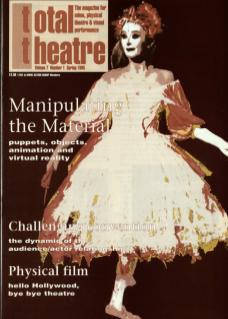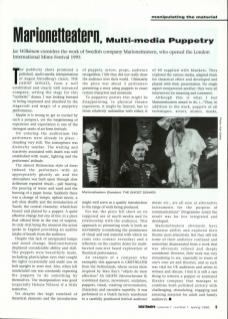The publicity shots promised a polished, multimedia interpretation of August Strindberg's classic The Ghost Sonata, from a well established and clearly well resourced company, setting the stage for this ‘symbolic’ drama. I was looking forward to being impressed and absorbed by the stagecraft and magic of a puppetry performance.
Maybe it is wrong to get so excited by such a prospect, yet the heightening of experience and expectation is one of the strongest assets of artform festivals.
On entering the auditorium the performers were already in place – standing very still. The atmosphere was distinctly sombre. The waiting and inactivity associated with death was well established with music, lighting and the performers' attitude.
The almost Dickensian style of dress imbued the performers with an appropriately ghostly air and the atmosphere was built upon through slow deliberate repeated rituals – pall bearing, the pouring of water and sand, and the burning of a paper house. Suddenly there was a change of tempo, upbeat music, a soft shoe shuffle, and the introduction of Yacob, the central character, wheelchair bound and played by a puppet. A quite effective change but one of few, in a piece that offered little in the way of surprise, its only rival being the moment the actors spoke in English provoking an audible intake of breath from the audience
Despite this lack of unrepeated tempo and mood change, Marionetteatern displayed considerable ability and skill. The puppets were beautifully made, including plastic/glass eyes that caught the lights occasionally and made you sit bolt upright in your seat. Also, when left unattended one was constantly expecting the puppets to do something by themselves. The manipulation was good (especially Helena Nilson) if a little restrictive.
Yet despite the high standard of theatrical elements and the introduction of puppets, actors, props, audience recognition, I felt they did not really draw the audience into their world. Ultimately the piece was about three performers presenting a story using puppets to enact certain characters and moments.
To puppetry purists this might be disappointing, to physical theatre exponents, it might be limited, but to those relatively unfamiliar with either, it might well serve as a quality introduction to the range of work being produced.
For me, the piece fell short on its supposed use of multimedia and its relationship with the audience. This approach to presenting work is both an inevitability (considering the prominence of visual and oral material with which we come into contact everyday) and a reflection on the creative desire for multifaceted non-text-based exploration of theatrical performance.
An example of a company who exemplify this approach is Griftheater from the Netherlands, whose recent show inspired by Man Ray's ‘objets de mon affection’ Sa Griffe (Monochrome 8) combined dance, movement, sculpture, puppets, ritual, creating environments, characters and narrative superbly. It was performed in a Dutch factory warehouse to a carefully positioned festival audience of 40 supplied with blankets. They explored the various media, adapted them for theatrical effect and developed and played with their presentation. No single aspect overpowered another: they were all interwoven for meaning and comment.
Although this is what I feel Marionetteatern aimed to do (‘Thus, in addition to the work, puppets of all techniques, actors, mimes, masks, music etc, are all seen as alternative instruments for the purpose of communications’ – Programme note) the result was far less integrated and developed.
Marionetteatern obviously have immense ability and explored their theatre most attentively. But they still left some of their audience confused and somewhat disassociated from a work that was obviously refined and deeply considered. However, their work was very stimulating to see, especially in terms of one's own art and theories, and as such was vital for UK audiences and artists to witness and discuss. I feel it is still a rare thing to witness a puppet or animated theatre company that manages to combine both polished artistry with challenging, stimulating, engaging and amusing material for adult and family audiences.

